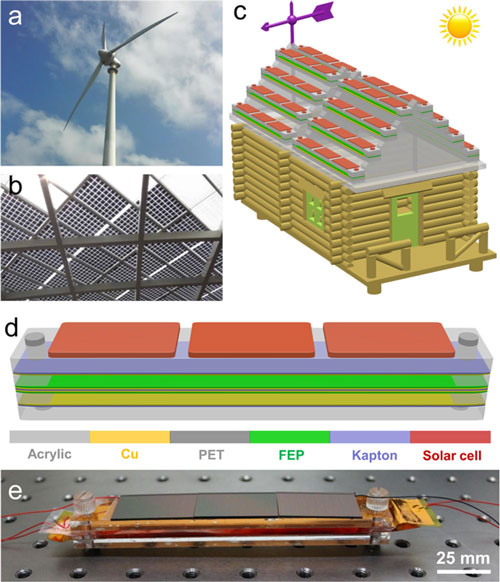|
原文链接:http://www.nanowerk.com/spotlight/spotid%3D43477.php
(Nanowerk Spotlight) More than 60 research groups worldwide are now developing variations of the triboelectric nanogenerator (TENG), which converts ambient mechanical energy into electricity for powering wearable electronics, sensor networks, implantable medical devices and other small systems. |
| Self-powered nanotechnology based on these nanogenerators aims at powering nanodevices and nanosystems using the energy harvested from the environment in which these systems are suppose to operate. This offers a completely new approach for harvesting mechanical energy using organic and inorganic materials. |
| An interesting approach comes from a group of Chinese scientists who propose to scavenge the large amounts of wasted wind energy in cities. |
| In a paper in the May 5, 2016 online edition of ACS Nano ("Efficient Scavenging of Solar and Wind Energies in a Smart City"), they propose hybridized nanogenerator that consists of a solar cell and a TENG, which can be utilized to individually or simultaneously scavenge solar and wind energies. |
| "Under a= device area of about 120 mm 22 mm, the solar cell can deliver an output power of 8 mW, while the corresponding output power of the TENG can be up to 24 mW," Prof. Ya Yang from the Beijing Institute of Nanoenergy and Nanosystems, tells Nanowerk. "We have utilized a transformer to decrease the impedance of the TENG for achieving the impedance matching between the solar cell and the TENG." |
 |
| (a) Photograph of conventional wind turbine generator. (b) Photograph of the integrated solar cell units on the roof of a city building (c) Schematic diagram of the integrated hybridized nanogenerators on the roof of a house model. (d) Schematic diagram of the fabricated hybridized nanogenerator. (e) Photograph of the fabricated hybridized nanogenerator. (Reprinted with permission by American Chemical Society) (click on image to enlarge) |
| The team's device structure incorporates a vibration film at the middle of the TENG that includes a Kapton film with two copper (Cu) electrodes on both sides, where the FEP (fluorinated ethylene propylene) film as the triboelectric layer was affixed on the copper electrode. Another two copper electrodes were fixed on the top and bottom of the acrylic substrate, respectively, resulting in an air gap has been created between the two copper electrodes. |
| The TENG's dimensions are tiny: The thickness of both the Kapton film and FEP film is about 25 m, and the thickness of the copper electrode is about 200 nm. The air gaps between the vibration film and the copper electrode on the acrylic substrate are 2 mm, so that the height of air intake is about 4 mm. |
| While the hybrid solar cell / TENG device could ideally be installed on roof tops, individual TENG arrays could be used anywhere to capture air movement, for instance at air condition units' outlets. |
| "The working of the TENG is based on the wind-induced vibration of the middle Kapton/Cu/FEP films, resulting in the periodic contact and separation between the FEP and the top/bottom copper film as both the conductive electrode and the triboelectric material," explains Yang. "The output current of the TENG can reach 260 A under a wind speed of about 15 m/s. This output current decreases with increasing the loading resistance, resulting in that the largest output power of the TENG can be up to 26 mW under the responding loading resistance of 1 M ." |
| In their experiments, the team used a homemade Li-ion battery with a TiO2 nanotube array as the electrode material to store energy generated by the hybridized nanogenerator. |
| "Our research holds great promise for practical applications to maximize solar and wind energies scavenging from the environments in the city areas for realizing some self-powered functions – such as sensors – in a 'smart city' environment," concludes Yang. "The next stages in our investigations will focus on the following two aspects: the first one is to improve the stability of the hybridized device output; the other one is design a new management circuit for TENG to obtain a higher current signals and voltage about 5V." |
| By Michael Berger. Copyright Nanowerk |

